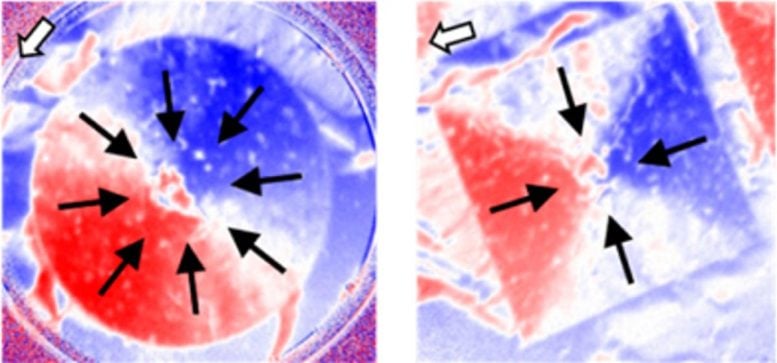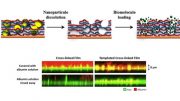
Researchers have developed a method to create and stabilize complex spin textures, like radial vortices, using superconducting structures and surface defects. This advancement could significantly impact spintronics by allowing the use of various ferromagnetic materials and enhancing data storage and logic operations with lower power consumption. Credit: SciTechDaily.com
A team at HZB has investigated a new, simple method at BESSY II that can be used to create stable radial magnetic vortices in magnetic thin films.
In some materials, spins form complex magnetic structures within the nanometre and micrometer scale in which the magnetization direction twists and curls along specific directions. Examples of such structures are magnetic bubbles, skyrmions, and magnetic vortices.
Spintronics aims to make use of such tiny magnetic structures to store data or perform logic operations with very low power consumption, compared to today’s dominant microelectronic components. However, the generation and stabilization of most of these magnetic textures is restricted to a few materials and achievable under very specific conditions (temperature, magnetic field…).
A New Approach
An international collaboration led by HZB physicist Dr Sergio Valencia has now investigated a new approach that can be used to create and stabilize complex spin textures, such as radial vortices, in a variety of compounds. In a radial vortex, the magnetization points towards or away from the center of the structure. This type of magnetic configuration is usually highly unstable. Within this novel approach, radial vortices are created with the help of superconducting structures while their stabilization is achieved by the presence of surface defects.

The team led by Sergio Valencia analyzed the samples with photoemission electron microscopy using XMCD at BESSY II. The images show the radially aligned spin textures in a round and a square sample consisting of a ferromagnetic material on a superconducting YBCO island. The white arrow shows the incident X-ray beam. Credit: © HZB
Superconducting YBCO-Islands
Samples consist of micrometer-sized islands made of the high-temperature superconductor YBCO on which a ferromagnetic compound is deposited. On cooling the sample below 92 Kelvin (-181 °C), YBCO enters the superconducting state. In this state, an external magnetic field is applied and immediately removed. This process allows the penetration and pinning of magnetic flux quanta, which in turn creates a magnetic stray field. It is this stray field that produces new magnetic microstructures in the overlying ferromagnetic layer: spins emanate radially from the structure center, as in a radial vortex.
The Role of Defects
As the temperature is increased, YBCO transits from the superconducting to a normal state. So the stray field created by YBCO islands disappears, and so should the magnetic radial vortex. However HZB researchers and collaborators have observed that the presence of surface defects prevents this to happen: the radial vortices partially retain the imprinted state, even when approaching room temperature.
“We use the magnetic field generated by the superconducting structures to imprint certain magnetic domains on the ferromagnets placed on them, and the surface defects to stabilize them. The magnetic structures are akin to that of a skyrmion and are interesting for spintronic applications,” explains Valencia.
Geometry Matters
Smaller imprinted vortices were about 2 micrometers in diameter, about ten times the size of typical skyrmions. The team studied samples with circular and square geometries and found that circular geometries increased the stability of imprinted magnetic radial vortices.
“This is a novel way to create and stabilize such structures and it can be applied in a variety of ferromagnetic materials. These are good new prospects for the further development of superconducting spintronics,” says Valencia.
Reference: “Size-Dependence and High Temperature Stability of Radial Vortex Magnetic Textures Imprinted by Superconductor Stray Fields” by David Sanchez-Manzano, Gloria Orfila, Anke Sander, Lourdes Marcano, Fernando Gallego, Mohamad-Assaad Mawass, Francesco Grilli, Ashima Arora, Andrea Peralta, Fabian A. Cuellar, Jose A. Fernandez-Roldan, Nicolas Reyren, Florian Kronast, Carlos Leon, Alberto Rivera-Calzada, Javier E. Villegas, Jacobo Santamaria and Sergio Valencia, 2 April 2024, ACS Applied Materials & Interfaces.
DOI: 10.1021/acsami.3c17671









Be the first to comment on "Spintronics Breakthrough: Unlocking the Power of Radial Vortices"